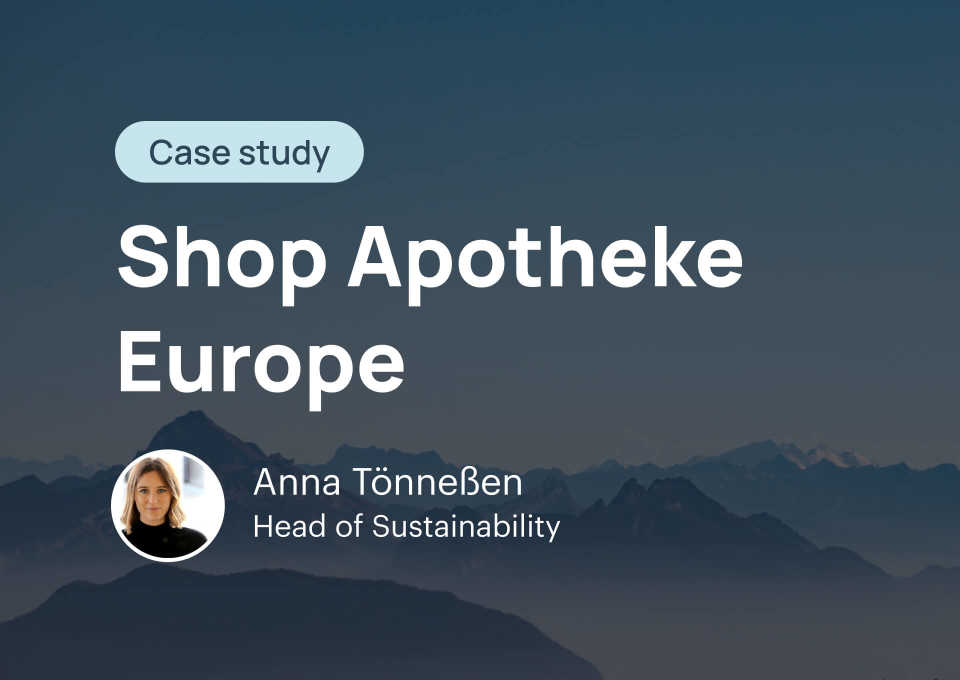As of February 2021, right. based on science (“right.”) is a verified member of the LFCA community. Among the companies who have also joined by taking the Green Pledge, we discovered one of our own clients – SHOP APOTHEKE EUROPE. In honor of Earth Week, we spoke to Anna Tönneßen, Manager Sustainable Development, about their journey towards a science-based climate strategy. The aim is to provide inspiration and practical insights for companies who are just starting to approach their Corporate Carbon Footprint and aligning their business model with the Paris climate target.
SHOP APOTHEKE EUROPE pursues climate action in different ways: You have taken a Green Pledge with the LFCA and are working with right.’s X-Degree Compatibility (XDC) Model. Can you explain how both aspects interact?
AT: Almost exactly one year ago, in the context of joining the LFCA community, we realised that if we want to fulfil this pledge, we first have to look at how many emissions there actually are. We then took the first step with the Corporate Carbon Footprint and realised that [the LFCA’s] “Basic Climate Neutrality” survey, which focuses on Scope 1 [direct] and 2 [purchased energy] emissions, is not really the main sticking point for us. We wanted to know more and measure immediately what is behind the Scope 3 [value chain] emissions, which are a major factor for us [For more on Scope 1, 2, and 3 emissions, see: GHG Protocol].
Once we had achieved a good data foundation, we needed to find a way of implementing emission reduction within the company, to drive it into the departments and give the managers who are responsible for the different functions in the company something to work with, following their cost logic. For this reason, we decided to directly expand the Green Pledge for Scope 1 and 2 and to apply it to the entire company, […] and to then distribute the costs of offsetting across the individual departments […]. [We applied] the logic of an “internal carbon tax” which creates an incentive to reduce emissions and costs.

For example, the department responsible for logistics gets the costs for the reduction on its own cost centre, which is linked to the shipping of our packages. Thus, the Green Pledge and offsetting our emissions was only the first step - the second step was finding a guideline we could use to determine the emissions reduction we have to achieve. As it is our main goal to reduce emissions, we needed a reduction target and that's where Temperature Alignment and the XDC Model come into play. It was clear to us that our target setting should be measured this way - not just by looking at what we CAN reduce, but what we MUST reduce to make an adequate contribution as a company.
What do you expect from working with the XDC Model?
AT: Personally, I am a fan of impact measurement following the IOOI (Input, Output, Outcome, Impact) logic. For us, Temperature Alignment is simply a very good way to approach this impact level. We can of course state that we emit X tonnes of CO2, but what does that actually mean for society? What is the impact or meaning of such a number measured in tonnes? In my opinion, expressing this in terms of °C is extremely exciting.
Furthermore, we see it as a challenge for us to educate internally, as well as externally, and to create awareness for the topic and then to somehow break down the complex climate mitigation challenge in our company and make it tangible. I think that the XDC Model, starting with the Climate Impact Report that we are doing right now, gives us a super practical and actionable tool to see where we are today and what we need to do to become 1.5°C-aligned in the future.
You talked about expanding your carbon footprint to cover Scope 3 emissions. We know that is a big undertaking – how did you go about it and what were key challenges or insights for you?
AT: None of us at SHOP APOTHEKE EUROPE has dealt with carbon accounting [on the company level] before. We had no idea how to map this across an entire organisation, how to make it tangible and we thought we had zero data at hand. At that stage, ClimatePartner was extremely helpful: the way we were taken by the hand, but also their vast experience which allowed them to share a lot of data with us or to show us ways of estimating emissions in areas where we still had gaps. That's why the first lesson we’d share is very clear: It's worth getting started, you actually find ways. Even though it might seem impossible at first, things get clearer step by step. It is a super exciting project when you have to work with all departments of the company to find ways to get data that is as realistic as possible, upon which we can then base our emissions reduction in the coming years. It was an extremely positive experience and really exciting for colleagues to understand that they are part of our sustainable development journey and can have an impact through their day-to-day business.
What gave us great security at the beginning was to learn about standards such as the GHG Protocol, where the boundaries are well-defined. This has given us a guideline of what we should include and what not, which has simplified data generation, because there is a certain point where we don't have to dig deeper. Another lesson is that the less effort you put into generating data, the more difficult it is to see the effect of the emissions reduction afterwards. For example, when we ask a question like: How do our employees drive to work? If we take an estimate beforehand and then want to see the effects of an initiative next year, then we can of course no longer count on the estimated data, which makes the effect the measure had at that point less tangible. This always remains a difficult balance for us: How much time and effort do we put into the smallest detail of primary data and where can we estimate and still reach a realistic and rather conservative value, without having used an entire year and three departments on generating all the data. That is a tightrope that everyone must walk on.
What tips do you have for companies that are tackling their carbon footprint for the first time?
AT: Firstly, just go for it, and when you do it you realise "wow, it's possible". The second is to look for a provider that has a cloud-based or digitalised approach, where you can access a lot of data and don't have to calculate yourself what the tonne-kilometre figure means for your emissions, or how you can get data for this or that packaging. Having a lot of data already stored was an extreme relief for us - in terms of effort and costs - and made it possible to implement everything so quickly within a year. And the third is to involve as many people in the company as possible in setting up the footprint, because there are a lot of experts in the different departments who can improve the whole project. So, someone from a sustainability department who thinks "we can do it this way or that way" starts talking to other people who might also have an interest in the topic and might suggest completely different ways. Those are light bulb moments that speed things up and improve data quality in the end.
What first indications or insights have you been able to gain from your analysis with the XDC Model so far?
AT: We are still at the very beginning, but at first glance it seems that we are not faring so badly. Our initial impression was that we have a business model that is rather bad for the climate, and then we saw that we are not doing badly compared to our sector. That was the first realisation, which would then of course – depending on the final result - also have an impact on our materiality analysis. Nevertheless, "a little better than others" does not mean that we are doing well. It remains an issue on which we continue to work on and where we see potential, simply because climate change is the most urgent problem the world is facing.

Has your experience with your carbon footprint or the XDC Model caused you to rethink the company’s data collection points or processes, now that you have seen what data is needed to be able to measure emissions so dynamically and genuinely against the actual target?
AT: One practical example is our energy supply – we now collect data over the course of the year, which can lead to better control in the next step. This means there is no additional procedural effort; we can simply extract the data once we need it.
The next step for us, or rather the question we are asking ourselves, relates to the mobility data of employees. We haven't found a solution yet, but we are working on how we can approach this in such a way that it is a valid database and not a query we run only once a year. So, we are currently investigating how we can actually record emissions during a business trip or in accounting, or what route each individual travels to the office, and how much they work from home. We want to find out if there are realistic ways of recording these things directly and automatically.
Our last question relates a bit more generally to dynamic digital companies per se. What role can decarbonization along the lines of climate science play in their market?
AT: One point is that digital companies are extremely data-driven - we simply don’t do anything without data. Of course, having a scientific climate model in the background, which is also software-based, helps with being efficient and therefore also fast. That's something that digital companies can do, perhaps better than larger or more established companies, because it’s kind of our thing, to move fast. In this respect, if we have a clear data foundation that we can rely on, a science-based reduction path is something we want to stick to.
That's where we want to put our energy - how can we develop our organisation and implement the reduction well? That brings us back to our first topic: how can we empower colleagues so that they can make decisions on how we can become more sustainable or, in this case, Paris-aligned. However, this requires certainty or an understanding in the specific areas where decisions must be made to be able to take on this responsibility. Here, a scientific foundation, which can be expressed in simple metrics such as °C, is crucial for increasing knowledge and empowerment throughout the different departments.



